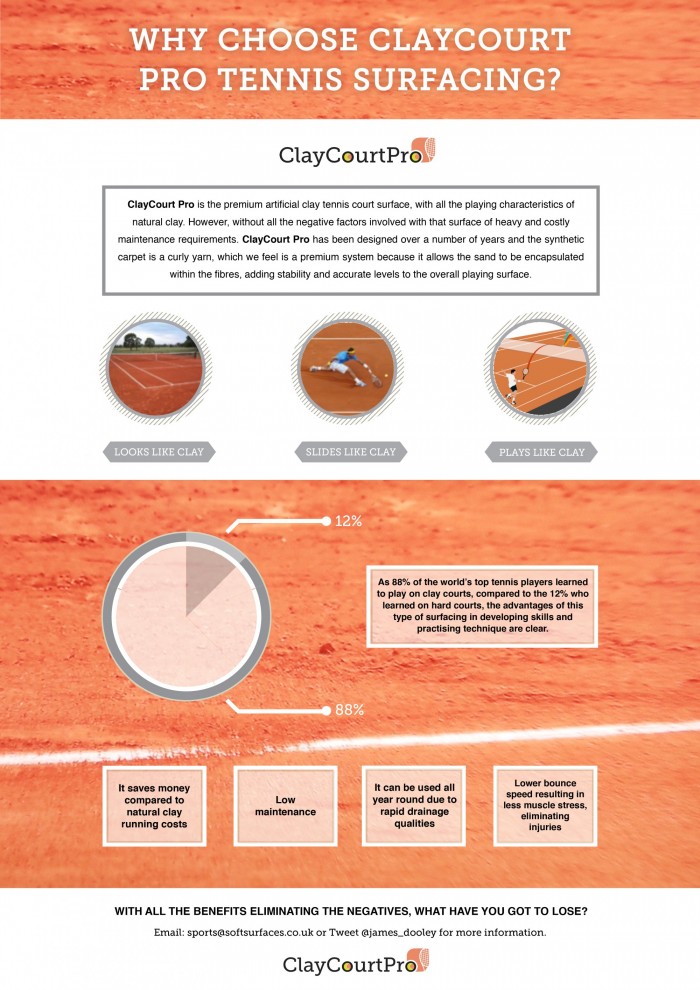Clay tennis court surfaces are favourable for many professional tennis players and the lack of these facilities in the UK means that players have to travel abroad to properly train and improve their skills. The biggest advantage of a clay tennis court is the soft and comfortable feeling it gives players underfoot, reducing impact on joints and preventing injuries during training and game play. A clay tennis court surface can also slow down the ball, making rallies longer and allowing players to develop their skills more than they could on a hard court.
However there are disadvantages of natural clay courts as the surfacing is not porous so it becomes unusable in wet conditions and also requires a lot of maintenance to keep up the best playing characteristics. So how can you get the benefits of a clay tennis court without the heavy maintenance and problems which come with natural clay?
Synthetic Clay Tennis Court Surface
Having a synthetic clay tennis court facility installed at your club or school can give young tennis players the opportunity to practise on a court which replicates the popular performance characteristics of natural clay. Artificial clay court surfacing is made up of two main parts – a coloured carpet surface and a layer of sand, this design gives the appearance and playability of real clay surfacing but without the heavy maintenance requirements. This reduces the strain on resources and budget for your organisation and means there can be more time spent enjoying tennis and less time spent maintaining and relining the surface of the court.
Here are the main benefits of having a synthetic clay tennis court surface installed:
- The artificial clay surfacing can be used in all weather conditions due to its porous properties which allow water to rapidly drain straight through instead of pooling and flooding on the surface.
- These sport surfaces are very low maintenance compared with natural clay courts which need watering and brushing every day to maintain good playing qualities. For the synthetic clay tennis court surface, regular drag brushing and redistribution of infill and removal of dirt and debris should be enough to keep the facility in top condition.
- The natural playing qualities which come with synthetic clay court surfacing mean that it can replicate the characteristics of real clay in terms of slide, ball bounce, ball speed and spin.
- High specification yarn is used for the synthetic carpet which gives the synthetic court surfacing professional qualities, and good UV stability prevents colour fading and keeps the court looking brand new.
- Installing an artificial clay tennis court surface can be very cost effective for a club or school as the synthetic carpet can be installed over an existing hard court which may be damaged. Minor repairs can be carried out and the new surfacing laid out on top of macadam without the need for an expensive resurfacing project. The low maintenance requirements also make artificial clay courts cost effective and sustainable for local tennis clubs which may not be able to afford the upkeep of a natural clay surface.
- As synthetic clay doesn’t throw up dust and doesn’t need to be watered, this surface specification can be used for indoor tennis courts as well as outdoor ones.
- ITF accreditations endorse these artificial clay tennis surfaces with a court pace 2 medium/slow classification to support the playing qualities as replicating real clay courts.

Clay Court Pro – An infographic by the team at Artificial Tennis Clay Court Surface
Embed Clay Court Pro on Your Site: Copy and Paste the Code Below
Creating Future Tennis Stars
As 88% of the world’s top tennis players learned to play on clay courts, the advantages of this type of surfacing in developing skills and practising technique are clear. However real clay courts are not always sustainable for schools and clubs which have a limited budget, so a synthetic clay court surface is an ideal alternative which still provides the top performance capabilities of natural clay. The high specification synthetic carpet holds the sand infill within its fibres to create a stable and even playing surface and the overall system provides ideal slip resistance and drainage properties.
Have you ever thought of having a synthetic clay tennis court surface installed? Use our enquiry form to send us over any questions or queries you have in regards to specifications and installation of this type of facility. You can also have a look at our website at http://sportsandsafetysurfaces.co.uk/ to see more details of the work we carry out and some of our previous sport surfacing projects.
What is your favourite type of tennis court surface? Clay, grass, macadam or polymeric? Tell us your thoughts below and please share this post if you thought it was useful!
